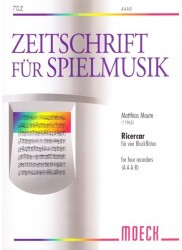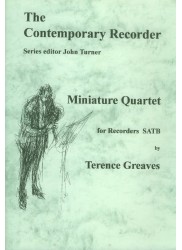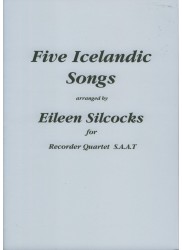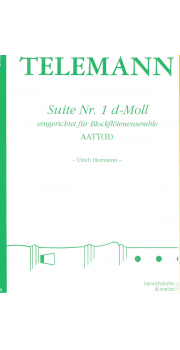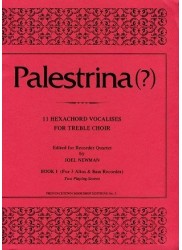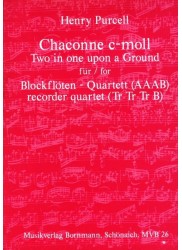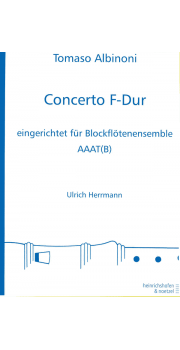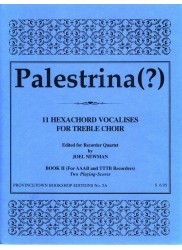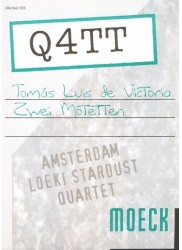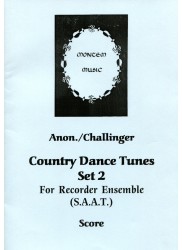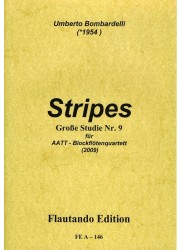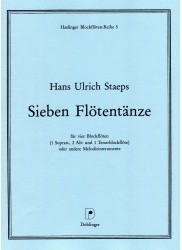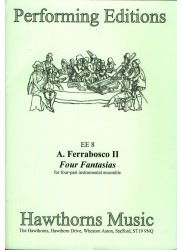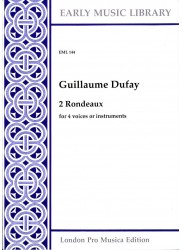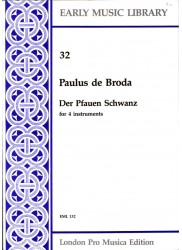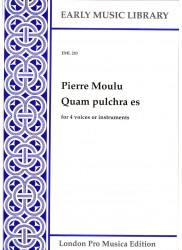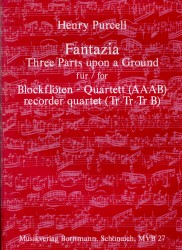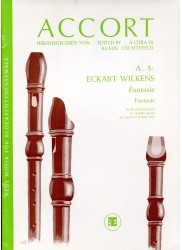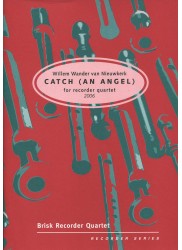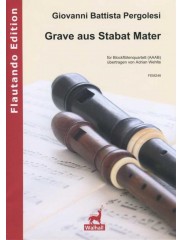No products
Prices are tax included
Agnistoma II
Composer: Irlandini - Luigi
Instrumentation: 2 Trebles - 2 Tenors
Period/genre: Australian Contemporary
Grade: Difficult - Very Difficult
More info
*Contemporary Piece.* Complex and energetic work requiring pinpoint rhythmic accuracy and ability to swap instruments from sopranino to great bass.
1. Agnistoma II
_Score 8 pp. Parts 4 pp._
OMP062 Luigi Irlandini, Agnistoma II
Luigi Irlandini was born in 1958 and studied in Brazil, Italy with Franco Donatoni, and USA with Brian Ferneyhough. Of Agnistoma II the composer says that it "is a polyphonic elaboration of the rhythmic-melodic materials in Agnistoma I, a piece for voice, two soprano recorders, and didjeridu, on a hymn from the Rig Veda, and sung in Sanskrit".
The title, Agnistoma, means "in praise of fire", and the pyrotechnics get underway from the outset with a tapestry of triplet quavers woven together which, subsequently, develop into quintuplets. The texture is densely packed with all four voices almost continuously busy. Moments of repose occur when the players, originally required to play two altos and two tenors, are asked to change instruments, expanding the range from sopranino to great bass for a calm central section. Music similar in style to the opening signals the final section of this intense and difficult work.
Aficionados of contemporary music will enjoy studying Agnistoma II, whilst I, for one, eagerly await experiencing this particular piece, either as a performer or listener, when the blue touch paper is lit on the concert stage.
Adam J Dopadlik, The Recorder Magazine, Winter 2001
OMP067 Benjamin Thorn Deep Sea Perspectives
OMP065 Tony Lewis Zaida Gaire
OMP062 Luigi Irlandini Agnistoma II
Though very different from each other, these ensemble pieces have something in common: their primary difficulty is rhythmic, not technical. Benjamin Thorn's Deep Sea Perspectives is the most accessible of the three. It offers two through-composed movements in a very conservative melodic style with simple tonal harmonies. The first movement, in G minor, is in a gently-flowing 6/7 meter that is not difficult to negotiate. The second movement develops from the same initial motif as the first, but recast in C Major and in a 5/8 meter that is sometimes grouped 3+2, other times 2+3. That wouldn't be terribly hard, were it not for the very fast tempo demanded by Thorn. At crotchet=150, this movement is quite difficult to maintain.
Zaida Gaire by Tony Lewis is a rhythmically-driving and highly-repetitive minimal work in a pan-diatonic language. It sets against each other different melodic/rhythmic patterns, consisting mostly of eighth notes and eighth rests, resulting in an abundance of hockets. While the individual parts may be fairly easy to play by themselves, performing them together is quite a task. This piece requires a great deal of precision and focus.
Luigi Irlandini's Agnistoma II, the least accessible of these works, is uninteresting to play and difficult to execute and conceptualise. The recorders chromatically hover over narrow tessituras, often clashing with each other in intervals of a second. Rhythmically it features an aperiodicity that is generated from tying together odd-shaped rhythmic cells. The rhythmic contours that result from this procedure are extremely complex and precisely notated. They must also be precisely-performed.
These editions are nicely printed and have no bad page turns. Deep Sea Perspectives is suitable for advanced amateurs. Zaida Gaire requires a very high-end amateur group working with a good teacher. Agnistoma II is strictly for professionals.
Pete Rose, American Recorder, March 2003
30 other products in the same category:
Reference: OMP185
Brand: Orpheus Music
Suite for Recorder Quartet Op 116
Composer: Maddox - Richard Peter Instrumentation: Descant - 2 Trebles -...
In StockReference: OMP157
Brand: Orpheus Music
Monet's Bridge
Composer: Pye - David Instrumentation: 2 Trebles - 2 Tenors Period/genre:...
In StockReference: OMP157.pdf
Brand: Orpheus Music
Monet's Bridge
PLEASE NOTE - DOWNLOADABLE PDF VERSION Composer: Pye - David...
$20.50 -20%In StockReference: ZFS806
Brand: Moeck
Kingfishers
Composer: Termohlen - Nicola Arranger: Paul Leenhouts Instrumentation: 2...
In StockReference: ZFS813
Brand: Moeck
Wanzenwanderung [Travelling Bugs]
Composer: Termohlen - Nicola Instrumentation: 2 Trebles - 2 Tenors...
In StockReference: PJT001
Brand: Peacock Press
Miniature Quartet
Composer: Greaves - Terence Instrumentation: Descant - 2 Trebles - Tenor...
In StockReference: P047
Brand: Peacock Press
Five Icelandic Folk Songs
Composer: Various Arranger: Silcocks - Eileen Instrumentation: Descant - 2...
In StockReference: N3778
Brand: Noetzel
Suite No 1 in d minor
Composer: Telemann - Georg Philipp Arranger: Ulrich Herrmann...
In StockReference: PBE05
Brand: Provincetown Bookshop
11 Hexachord Vocalises, Book I
Composer: Palestrina - G.P. (?) Arranger: Joel Newman Instrumentation: 3...
In StockReference: MVB026
Brand: Bornmann
Chaconne C minor Two in One upon a ground
Composer: Purcell - Henry Instrumentation: 3 Trebles - Bass Period/genre:...
In StockReference: N3776
Brand: Noetzel
Concerto in F Major
Composer: Albinoni - Tomaso Arranger: Ulrich Herrmann Instrumentation: 3...
In StockReference: PBE005A
Brand: Provincetown Bookshop
11 Hexachord Vocalises, Book II
Composer: Palestrina - G.P.(?) Arranger: Joel Newman Instrumentation: 3...
In StockReference: M2828
Brand: Moeck
Two Motets
Composer: Victoria - Tomas Luis de Arranger: Daniel Bruggen...
In StockReference: AC06
Brand: Montem Music
Country Dance Tunes Set 2
Composer: Challinger - AndrewInstrumentation: Descant - 2 Trebles -...
In StockReference: FEA146
Brand: Flautando Edition
Stripes, Grosse Studie No 9
Composer: Bombardelli - UmbertoInstrumentation: 2 Trebles - 2...
In StockReference: DO HBR5
Brand: Doblinger
Sieben Flöetentänze
Composer: Staeps - Hans Ulrich Instrumentation: Descant - 2 Trebles - Tenor...
In StockReference: EE08
Brand: Hawthorns
Four Four-Part Fantasias
Composer: Ferrabosco - Alfonso Instrumentation: Descant - 2 Trebles - Tenor...
In StockReference: TMR4
Brand: Schott
Peripheral-Diagonal-Concentric
Composer: Geysen - Frans Arranger: Frans Bruggen Instrumentation: 2 Trebles...
In StockReference: FEA126
Brand: Flautando Edition
Wege
Composer: Bombardelli - UmbertoInstrumentation: Descant - 2 Trebles -...
In StockReference: EML144
Brand: Early Music Library
2 Rondeaux
Composer: Dufay - GuillaumeInstrumentation: 2 Trebles - 2 TenorsPeriod/genre:...
In StockReference: EML156
Brand: Early Music Library
2 Rondeaux
Composer: De Machaut - GuillaumeInstrumentation: 2 Trebles - 2...
In StockReference: EML132
Brand: Early Music Library
Der Pfauen Schwanz
Composer: De Broda - PaulusInstrumentation: Descant - 2 Trebles -...
In StockReference: EML294
Brand: Early Music Library
Ave vera caro Christi
Composer: AnonymousInstrumentation: 2 Descants - Treble - Tenor (or Descant -...
In StockReference: EML283
Brand: Early Music Library
Quam pulchra es
Composer: Moulu - PierreInstrumentation: 3 Trebles - BassPeriod/genre:...
In StockReference: EML288
Brand: Early Music Library
O virgo benedicta
Composer: Silva - Andreas deInstrumentation: 3 Trebles - Bass (or Treble - 3...
In StockReference: MVB027
Brand: Musicverlag Bornmann, Schonaich
Fantazia Three Parts upon a Ground
Composer: Purcell - Henry Arranger: Johannes Bornmann Instrumentation: 3...
In StockReference: 2078PJT
Brand: PJ Tonger
Fantasia (1978)
Composer: Wilkens - Eckart Arranger: Klaus Luchtefeld Instrumentation:...
In StockReference: AMP1325
Brand: Ascolta
Catch (an Angel)
Composer: Nieuwkerk - Willem Wander van Instrumentation: Descant - 2 Trebles...
In StockReference: FEM246
Brand: Edition Walhall
Grave aus Stabat Mater
Composer: Pergolesi - Giovanni Arranger: Adrian Wehlte Instrumentation: 3...
In Stock




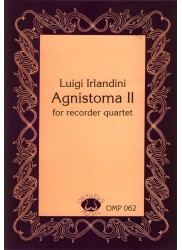
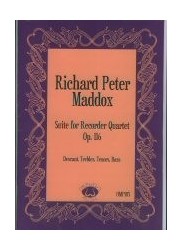
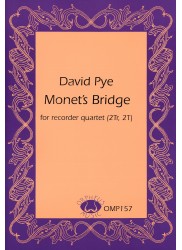


![Wanzenwanderung [Travelling Bugs]](https://orpheusmusic.com.au/5573-home_default/wanzenwanderung-travelling-bugs-.jpg)
